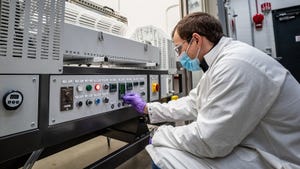Novel Flow Battery Technology may have Potential to Store Energy for 16 Years
Catholyte material produces cells that can provide power to dramatically improve grid-level storage.
September 15, 2021

While electric vehicles (EVs) are becoming increasingly popular with consumers, they still have limitations in terms of battery life and the mileage range that can be driven on a single battery charge—keeping automobiles running on fossil fuels as the dominant consumer option.
That could change once researchers figure out how to develop batteries for EVs that enable them to travel over long distances or time periods without having to recharge after a few hours or even every day.
A team of researchers at the University of Akron (UA) may have found a potential solution with the demonstration of new flow batteries that showed in the lab to store energy for cycling the device over an unprecedented amount of time—more than 16 years, they said.
The team, led by Yu Zhu, a professor in UA's School of Polymer Science and Polymer Engineering, developed the most stable catholyte, or positive electrolyte, to date for what are called aqueous organic redox flow batteries (AORFBs). These devices are eyed as the future for safe, dependable large-scale energy storage, he said.
“Development of high-performance RFBs will enrich the category of electricity energy storage systems and complement the shortcoming of intermittent renewable energy sources, therefore largely improving the usability of electricity-powered facilities, such as vehicles,” Zhu said in a press statement.
Overcoming Material Hurdle
RFBs already have been developed to provide grid-scale storage for renewable energies such as solar and wind power. However, current iterations of these devices use high-cost and environmentally hazardous active materials as their electrolytes, presenting a challenge to their widespread development and use.
AORFBs use water-soluble organic materials as electrolytes in the RFBs; these materials can be obtained from renewable sources and manufactured at a very low cost. However, so far, scientists have lacked the existence of a stable water-soluble organic electrolyte material--particularly for the positive electrolyte in an AORFB, called the catholyte.
“To significantly improve the performance of aqueous organic RFBs, the urgency of developing new catholyte is crucial,” Zhu said.
To solve this problem, he and his team demonstrated a state-of-the-art catholyte for AORFBs developed with a new strategy to design water-soluble catholytes for the enhancement of their solubility, or energy density, in water.
For the latter, researchers used a hydrophilic functional group to improve the solubility of the molecules, which changed the symmetry of molecules. This resulted in a significant enhancement of solubility in the catholyte, researchers said.
Unprecedented Energy Storage
Using their catholyte, researchers demonstrated cells that kept more than 90 percent of their energy capacity over 6,000 cycles--projecting more than 16 years of uninterrupted service at a pace of one cycle per day, they said.
Researchers published a paper on their work in the journal Nature Energy. They also submitted a patent application based on the technology.
The team plans to use their new design strategy to develop new materials that can enhancement to development of AORFBs further to create more sustainable large-scale energy sources over the long term, Zhu said.
This scalability will be studied further through a spin-off company he founded called Akron PolyEnergy Inc., which is focusing on the development of materials in energy storage devices, including not only flow batteries but also lithium-ion devices, Zhu said.
Elizabeth Montalbano is a freelance writer who has written about technology and culture for more than 20 years. She has lived and worked as a professional journalist in Phoenix, San Francisco, and New York City. In her free time, she enjoys surfing, traveling, music, yoga, and cooking. She currently resides in a village on the southwest coast of Portugal.
About the Author(s)
You May Also Like





